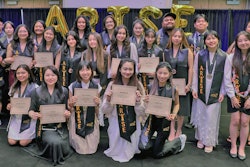WASHINGTON – Decades after being labeled the “model minority,” Asian Americans struggle with a stereotype that obscures significant socioeconomic, education, and health disparities within a group made up of more than 30 ethnicities in the U.S.
For Kiran Ahuja, the executive director of the White House Initiative on Asian Americans and Pacific Islanders (AAPI), communicating an accurate picture of Asian American diversity to policymakers across the federal government represents a fundamental task of the office she has been leading since this past November.
“It’s our job to make sure our colleagues have a good understanding of the unique issues that impact our community and how diverse we are,” Ahuja said during an interview at the U.S. Department of Education headquarters. “All Asian Americans are not doing well.”
Fighting against fiction goes with the territory, said Ahuja, who spends much of her time directing efforts to disaggregate data that give an incomplete picture of the more than 13 million Americans of AAPI heritage. She also reports to a 20-person commission that advises President Barack Obama on AAPI issues, which includes Education Secretary Arne Duncan and Commerce Secretary Gary Locke as co-chairs.
The Obama administration appointed Ahuja, who is Indian American, to her position after the president signed an executive order re-establishing the office, fulfilling a campaign commitment to increase the AAPI community’s visibility, access to, and participation in federal programs and services.
Originally established under the Clinton administration, the AAPI White House Initiative set out to improve the lives of AAPIs through coordination of leadership across federal agencies. While there was an AAPI business initiative in place at the Commerce Department, the Education Department-based initiative was inactive during the George W. Bush administration.
Asian Diversity
While established groups such as Japanese, Asian Indian, and Korean Americans show high levels of education and social mobility in national statistics, recently immigrated or refugee groups like Cambodians, Laotians, and Filipinos often do not share those same experiences.
Ahuja can run off a slew of statistics she has memorized, using research from scholars such as Dr. Robert Teranishi at New York University, to help contextualize the AAPI experience.
The mainstream media have reported that AAPIs fared well during the recession, but census data reveal that Pacific Islanders and Southeast Asians had unemployment rates three to five times greater than other groups such as Chinese Americans.
A large share of the AAPI population lives below the poverty level, has difficulty learning English, and is dropping out of high school at similar rates to poor Blacks and poor Hispanics. Several diseases challenge AAPI-descended people, including cancer, hepatitis, and HIV/AIDS. “They lump us all together, and the truth is we are not one monolithic group,” Ahuja said.
Misperceptions have hurt efforts by AAPI leaders vying for targeted resources and support from federal agencies, which continue to make broad generalizations about specific Asian sub-groups, Ahuja noted.
In the last decade, Asian Americans have fought and won recognition from higher education officials with a new federal designation for institutions serving large populations of AAPI students. The Asian American Native American, Pacific Islander Serving Institutions (ANNAPISI) designation was enacted under the College Cost Reduction Act of 2007 to identify colleges and universities where at least 10 percent of the student body is a member of the AAPI community. Six of those institutions have won grants to serve those student bodies and their specific higher learning challenges.
“It can be difficult to make the case, but what works for other groups, like increased funding for community colleges, also benefits the AAPI community,” Ahuja said.
Unlike the initiatives targeted at other minority groups, Ahuja’s focus and influence extend beyond education to multiple issues affecting AAPIs. From translating health information and finding funds for small businesses to advocating for Vietnamese fishermen affected by the Gulf oil spill, Ahuja coordinates efforts across 23 federal agencies, leveraging priorities for one of the fastest growing demographic groups in the nation.
At the Department of Education, Ahuja’s office is adjacent to those of the other executive directors of White House initiatives. The proximity has been advantageous, she said, and recently they have talked about an inter-initiative council to tackle shared issues.
Ahuja the Advocate
A longtime AAPI and women’s rights activist, Ahuja has leveraged her career inside government, as a civil rights lawyer, to venture into advocacy. She litigated in school desegregation cases for the Department of Justice and moved on to launch a nonprofit organization, the National Asian Pacific American Woman’s Forum, as a community leader.
AAPI leaders and politicians praised the appointment and welcomed the experience of a grassroots organizer free of the Beltway’s insider politics. Ahuja draws upon her unique background as an Asian Indian raised in the Deep South to inform her perspective on race, class, and gender issues.
“We are hopeful that more resources will be available to our communities and that this initiative will ensure a broader representation of Asian Americans and Pacific Islanders within our government,” Dr. Ho Luong Tran, president and CEO of Asian and Pacific Islander American Health Forum, told the Asian Journal newspaper group last fall.
Ahuja said leading the WhiteWe are hopeful that more resources will be available to our communities and that this initiative will ensure a broader representation of Asian Americans and House initiative is similar to her nonprofit experience. She is now working on putting the office together and opening communication pipelines between AAPI leaders and the federal agencies.
“When I got here and began re-establishing this office, there was really just myself, a phone, and a computer,” Ahuja said jokingly, flashing a star-shaped tattoo on her right forearm.
A graduate of Spelman College, Ahuja grew up in Savannah, Ga. among African-Americans and felt comfortable in Black institutions and churches. As a young adult, she later made her way into the AAPI community, she said.
“In the South, things are pretty Black and White, and then there was me the only brown person,” Ahuja said, adding that there wasn’t much of an Asian community in Georgia but that she did identify with the civil rights struggles of African-Americans. “In college, I began to understand I was a person of color,” she explained.
Inspired by Black history, Ahuja eventually gravitated to learning more about the U.S. AAPI population. It was a natural transition for Ahuja, who formed bonds with Asian American women across the country, unpacking stereotypes and advocating for reproductive justice.
Recalling stories she has heard while spending time among Asian Americans, Ahuja said she wants to eliminate the isolation many members of the AAPI community feel as immigrants—an experience she understands personally.
“There is a lot of work to be done in the AAPI community,” she said, adding that her priorities revolve around immigration, civil liberties, health, and education. “I feel a deep responsibility to breaking down the barriers in those communities and opening opportunities for them to thrive.”
















